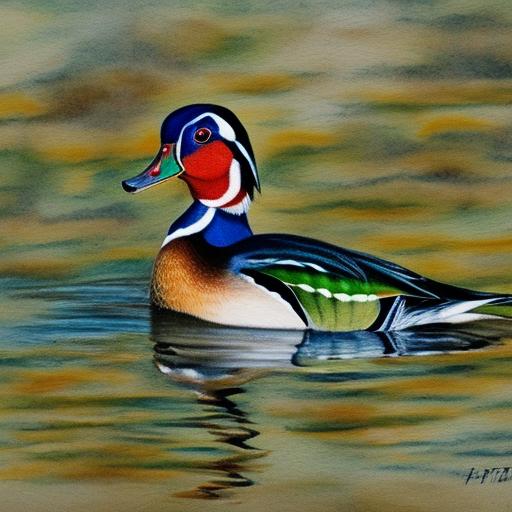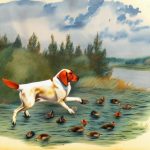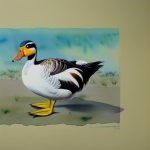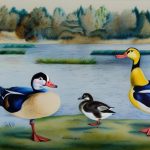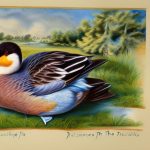Wood ducks, scientifically known as Aix sponsa, are one of the most stunning and colorful waterfowl species found in North America. These beautiful birds are known for their vibrant plumage, with the males sporting iridescent green and purple heads, red eyes, and distinctive white markings on their faces. The females, on the other hand, have a more subtle appearance with a grayish-brown body and a distinctive teardrop-shaped eye ring. Wood ducks are medium-sized, with a length of around 19 inches and a wingspan of 28 inches. They are commonly found in wooded swamps, marshes, and shallow lakes across the eastern United States and parts of Canada.
Wood ducks are unique among waterfowl in that they are cavity nesters, meaning they seek out natural tree cavities or man-made nest boxes to lay their eggs and raise their young. They are also known for their strong flying abilities and agility in flight, making them a delight to watch as they navigate through the dense vegetation of their wetland habitats. These ducks are also highly adaptable and can be found in a variety of habitats, from freshwater marshes to beaver ponds and flooded forests. Wood ducks are not only a sight to behold but also play a crucial role in maintaining the ecological balance of their habitats through their foraging and nesting behaviors.
Key Takeaways
- Wood ducks are colorful and unique waterfowl found in North America, known for their stunning plumage and distinctive nesting habits.
- Wood ducks prefer to nest in tree cavities near water, and they are known for their elaborate courtship displays and mating behavior.
- Female wood ducks lay around 10-15 eggs in their nests and are responsible for the majority of the incubation period, while the male helps protect the nest.
- After about a month of incubation, the eggs hatch and the ducklings are cared for by the female, who leads them to water and protects them from predators.
- Threats to wood ducks include habitat loss, hunting, and predation, but conservation efforts such as habitat restoration and nest box programs have helped increase their populations.
Nesting and Habitat Selection
Wood ducks are highly selective when it comes to choosing their nesting sites. They prefer to nest in wooded wetlands near water bodies such as rivers, lakes, and ponds. The availability of suitable nesting cavities is a crucial factor in their habitat selection, as they rely on natural tree hollows or man-made nest boxes to raise their young. In areas where natural cavities are scarce, conservation efforts have focused on providing artificial nest boxes to support wood duck populations.
The female wood duck is responsible for selecting the nesting site, often choosing a cavity located high above the ground to protect her eggs and ducklings from predators. Once a suitable site is found, the female will line the cavity with down feathers from her breast to create a soft and insulating nest for her eggs. The male may accompany the female during this process, providing protection and support as she prepares the nest. The selection of a secure nesting site is crucial for the survival of wood duck offspring, as it helps minimize the risk of predation and ensures the safety of the brood during the vulnerable early stages of development.
Courtship and Mating Behavior
Wood ducks are known for their elaborate courtship displays, which involve intricate behaviors and vocalizations designed to attract a mate. During the breeding season, male wood ducks engage in striking displays to showcase their vibrant plumage and courtship prowess. These displays often involve head bobbing, wing flapping, and vocal calls to capture the attention of females. The males also engage in competitive behaviors, such as chasing and displaying dominance over rivals, to establish their status and win the favor of a female.
Once a pair bond is formed, the male will accompany the female as she selects a nesting site and prepares the nest. The bond between male and female wood ducks is often strong, with both partners participating in the nesting process and caring for their offspring. This cooperative behavior is essential for the successful rearing of ducklings, as it allows both parents to contribute to the protection and care of their young.
The courtship and mating behaviors of wood ducks are not only fascinating to observe but also play a crucial role in ensuring the reproductive success of the species. By understanding these behaviors, researchers can gain valuable insights into the dynamics of wood duck populations and the factors that influence breeding success.
Egg-laying and Incubation
After selecting a suitable nesting site and preparing the nest, the female wood duck will begin laying her eggs. Wood ducks typically lay an average of 10-15 eggs per clutch, with one egg being laid each day until the clutch is complete. The eggs are creamy white in color and slightly pointed at one end, providing optimal shape for fitting into the nest cavity.
Once all the eggs have been laid, the female will begin incubating them by sitting on the nest to keep them warm and facilitate embryonic development. Incubation typically lasts for around 28-30 days, during which time the female will diligently tend to her eggs, turning them regularly to ensure even heat distribution and prevent the embryos from sticking to the shell.
While the female is primarily responsible for incubation, the male may stand guard nearby to protect the nesting site from potential threats. This cooperative behavior between male and female wood ducks helps ensure the safety and well-being of the developing embryos. The process of egg-laying and incubation is a critical stage in the reproductive cycle of wood ducks, laying the foundation for the successful hatching and rearing of their offspring.
Hatching and Duckling Care
After weeks of careful incubation, the eggs finally begin to hatch, signaling the start of an exciting new chapter in the life of wood ducks. The ducklings emerge from their shells with soft downy feathers and are quick to leave the nest cavity under the guidance of their mother. Once outside the nest, the female leads her brood to nearby water sources where they can begin feeding and learning essential survival skills.
Wood duck ducklings are precocial, meaning they are relatively independent and capable of feeding themselves shortly after hatching. However, they still rely on their mother for protection and guidance as they navigate their new environment. The female provides essential care for her ducklings, teaching them how to forage for food, avoid predators, and navigate through their wetland habitat.
The male may also play a role in caring for the ducklings, offering protection and support as they explore their surroundings. This cooperative parental care is crucial for the survival of wood duck ducklings, as it allows them to develop essential skills and behaviors that will help them thrive in their natural environment.
Threats and Conservation Efforts

Despite their stunning beauty and remarkable adaptability, wood ducks face a range of threats that impact their populations. Habitat loss and degradation due to urbanization, agriculture, and deforestation have led to a decline in suitable nesting sites for wood ducks. Additionally, pollution of water bodies and wetlands poses a threat to their health and well-being.
Predation is another significant threat to wood duck populations, with eggs and ducklings being vulnerable to predators such as raccoons, snakes, and birds of prey. Invasive species such as European starlings and house sparrows also compete with wood ducks for nesting cavities, further impacting their reproductive success.
To address these threats, conservation efforts have focused on habitat restoration, nest box programs, and predator management to support wood duck populations. By providing artificial nest boxes in suitable habitats and implementing predator control measures, conservationists aim to enhance nesting success and promote the recovery of wood duck populations.
In addition to habitat conservation, public awareness and education play a crucial role in promoting the conservation of wood ducks. By raising awareness about the importance of wetland habitats and the threats facing wood ducks, conservation organizations can mobilize support for initiatives aimed at protecting these iconic waterfowl.
Conclusion and Future Research
In conclusion, wood ducks are captivating waterfowl species that play a vital role in maintaining the ecological balance of wetland habitats across North America. Their stunning plumage, elaborate courtship displays, and cooperative breeding behaviors make them a fascinating subject for research and conservation efforts.
Future research on wood ducks could focus on understanding their migration patterns, wintering habitats, and population dynamics to inform effective conservation strategies. By studying their movements and habitat use throughout the year, researchers can identify key areas for protection and management to support healthy wood duck populations.
Furthermore, continued efforts to engage local communities in conservation initiatives will be essential for ensuring the long-term survival of wood ducks. By fostering a sense of stewardship for wetland habitats and promoting responsible land management practices, we can work towards creating a sustainable future for these magnificent waterfowl.
In conclusion, wood ducks are not only a symbol of natural beauty but also serve as indicators of wetland health and biodiversity. Through collaborative conservation efforts and ongoing research, we can work towards securing a bright future for wood ducks and the vital ecosystems they call home.
If you’re interested in learning more about the fascinating world of waterfowl, you might want to check out an article on PoultryWizard.com that discusses the breeding habits of wood ducks. This article provides valuable insights into the unique behaviors and challenges associated with wood duck breeding, offering a deeper understanding of these beautiful birds. You can find the article here.
FAQs
What is the breeding season for wood ducks?
The breeding season for wood ducks typically occurs from late winter to early spring, with nesting usually taking place between February and June.
Where do wood ducks build their nests?
Wood ducks build their nests in tree cavities, often using abandoned woodpecker holes or other natural cavities. They may also use nest boxes provided by humans.
How many eggs do wood ducks typically lay?
A female wood duck can lay anywhere from 7 to 15 eggs in a single clutch, with the average clutch size being around 10 to 12 eggs.
How long does it take for wood duck eggs to hatch?
Wood duck eggs typically take around 28 to 30 days to hatch after they have been laid.
Do wood ducks mate for life?
Wood ducks are not strictly monogamous, but they do often form long-term pair bonds. However, they may choose new mates in subsequent breeding seasons.
What do wood ducks eat during the breeding season?
During the breeding season, wood ducks primarily feed on a diet of seeds, fruits, aquatic plants, and insects. They may also consume small fish and crustaceans.
Meet Walter, the feathered-friend fanatic of Florida! Nestled in the sunshine state, Walter struts through life with his feathered companions, clucking his way to happiness. With a coop that’s fancier than a five-star hotel, he’s the Don Juan of the chicken world. When he’s not teaching his hens to do the cha-cha, you’ll find him in a heated debate with his prized rooster, Sir Clucks-a-Lot. Walter’s poultry passion is no yolk; he’s the sunny-side-up guy you never knew you needed in your flock of friends!

